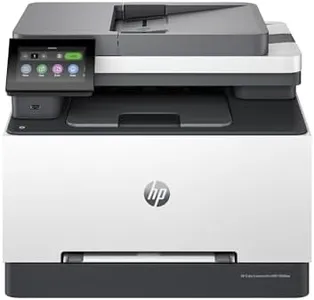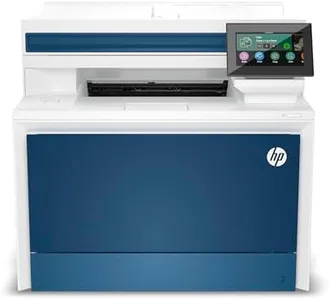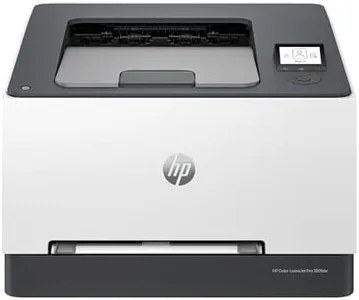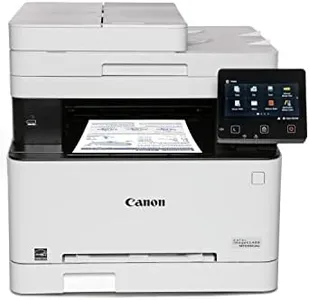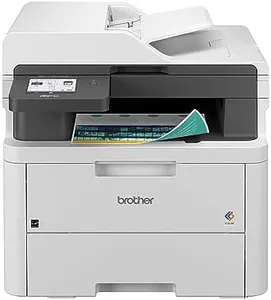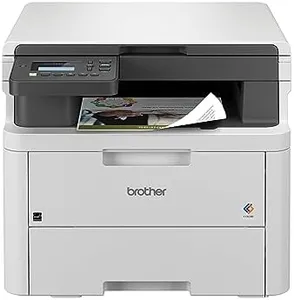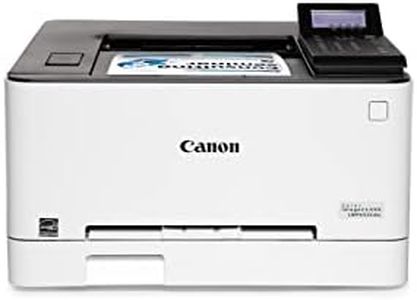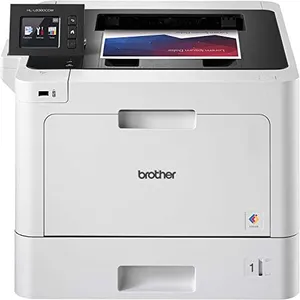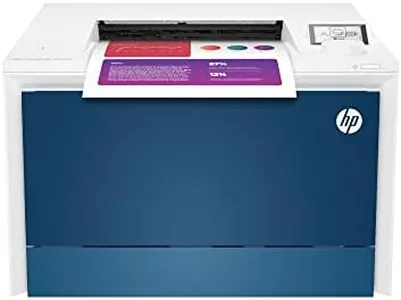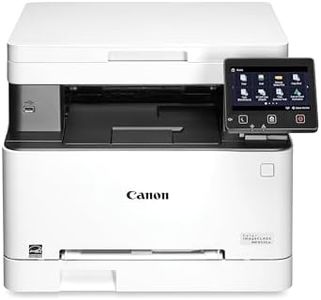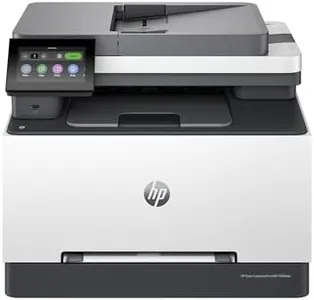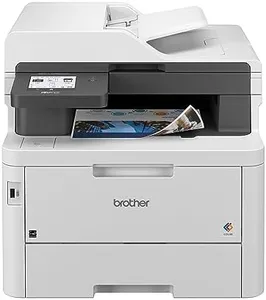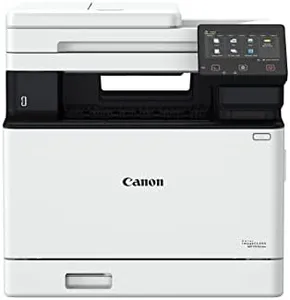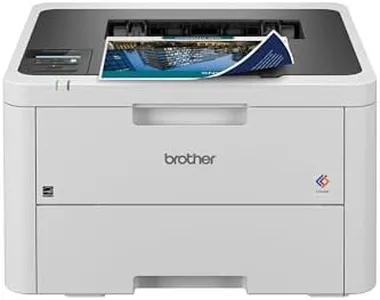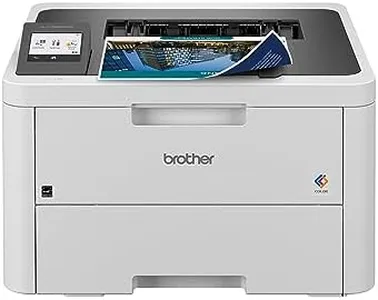10 Best Home Color Laser Printers 2025 in the United States
Our technology thoroughly searches through the online shopping world, reviewing hundreds of sites. We then process and analyze this information, updating in real-time to bring you the latest top-rated products. This way, you always get the best and most current options available.

Our Top Picks
Winner
HP Color Laserjet Pro MFP 3301fdw Wireless All-in-One Color Laser Printer, Office Printer, Scanner, Copier, Fax, ADF, Duplex, Best-for-Office (499Q5F)
Most important from
4745 reviews
The HP Color LaserJet Pro MFP 3301fdw is an all-in-one color laser printer designed for small teams and office environments. It boasts a respectable print speed of up to 26 pages per minute (ppm) for both black and color prints, making it efficient for high-demand tasks. The print quality is reliable with a maximum resolution of 600 x 600 dots per inch, suitable for professional-quality documents and reports. However, the print resolution may not be the best for high-detail graphic work or photo printing.
The printer supports a substantial duty cycle, ensuring it can handle a large volume of work without frequent maintenance. Connectivity options are robust, including Wi-Fi, USB, and Ethernet, allowing flexible and convenient access from multiple devices. Additionally, the printer supports wireless printing and comes with an HP app for easy control via smartphones. Paper handling is efficient with a 250-sheet input tray and an automatic document feeder (ADF) for scanning, copying, and faxing. The duplex (double-sided) printing and single-pass scanning features further enhance productivity and reduce paper use.
A notable drawback is the cost of consumables. The printer only works with original HP toner cartridges, and firmware updates ensure compatibility, which might lead to higher ongoing costs compared to third-party options. The device is relatively heavy at 37.7 pounds, which might be cumbersome for some users. Security features, including HP Wolf Pro Security, provide robust protection against cyber threats, making it a good choice for businesses concerned with data security. In terms of sustainability, the printer is designed to reduce plastic use and energy consumption, adding an eco-friendly touch. The HP Color LaserJet Pro MFP 3301fdw is a reliable and versatile choice for small office settings that require a multi-functional device capable of handling a variety of tasks efficiently.
Most important from
4745 reviews
HP Color LaserJet Pro MFP 4301fdw Wireless All-in-One Color Laser Printer, Scanner, Copier, Fax, Best-for-Office
Most important from
4358 reviews
The HP Color LaserJet Pro MFP 4301fdw is designed for small office environments and teams of up to ten people. It excels in printing speed, reaching up to 35 pages per minute in color, which is impressive for busy workspaces needing high-volume printing. The print quality is solid, with a resolution of up to 607 x 600 DPI, ensuring professional-looking documents and reports. Its all-in-one capabilities, including scanning, copying, and faxing, make it a versatile choice for various office tasks.
One of the standout features is its automatic duplex printing, which saves both time and paper. The printer also includes an auto document feeder, enhancing efficiency when handling multi-page documents. Connectivity options are user-friendly, providing intelligent Wi-Fi and mobile printing capabilities, allowing users to print wirelessly from smartphones, PCs, and laptops.
The printer's weight of 45 pounds may be a concern for some users, making it less portable. Additionally, while the cost of consumables is generally reasonable for a color laser printer, users should be aware that toner replacement can add up if you frequently print in color. The printer’s power consumption is also on the higher side at 585 watts, which might be a consideration for energy-conscious buyers. Security features like HP Wolf Pro Security are beneficial for protecting sensitive data, especially in office settings. Potential drawbacks include a somewhat limited input and output capacity compared to larger models, as well as a relatively bulky design. If you need a reliable printer for a small team with fast printing needs, this model is a solid option, but consider your space and budget for ongoing costs.
Most important from
4358 reviews
HP Color Laserjet Pro 3201dw Wireless Color Laser Printer, Office Printer, Duplex, Best-for-Office (499Q9F)
Most important from
2584 reviews
The HP Color LaserJet Pro 3201dw is a solid choice for small teams looking for a reliable home color laser printer. One of its standout features is its print speed, reaching up to 26 pages per minute for both black and color documents, making it efficient for handling numerous print jobs quickly. The print quality is enhanced by the next-generation TerraJet toner, which produces vibrant colors, ideal for professional documents and reports.
For busy office environments, this printer boasts a 250-sheet input tray and automatic duplex printing, allowing for less manual intervention and improving productivity. Its connectivity options are versatile, including dual-band Wi-Fi, USB, and Ethernet, which makes it easy to integrate into various setups and ensures you can print from multiple devices without hassle.
Security is a noteworthy consideration, as the HP Wolf Pro Security feature helps safeguard sensitive data, a crucial aspect for business users. Additionally, the printer is designed with sustainability in mind, being Energy Star and EPEAT certified, which may appeal to environmentally conscious buyers. However, there are a few drawbacks to consider. The printer's weight at 30.42 pounds means it's not the most portable option, and it might be challenging to move around. The requirement for original HP toner cartridges can lead to higher ongoing costs, especially if you're printing frequently. Users might find it inconvenient if cheaper third-party cartridges are blocked due to HP's firmware restrictions.
The HP Color LaserJet Pro 3201dw is a dependable home color laser printer that excels in speed and quality, making it suitable for small to medium office settings. Potential buyers should weigh the costs of consumables and the printer's relatively hefty build against their specific needs.
Most important from
2584 reviews
Buying Guide for the Best Home Color Laser Printers
Choosing the right home color laser printer can be a bit overwhelming with the variety of options available. The key is to understand your specific needs and how different features and specifications can meet those needs. Here are some important specifications to consider when selecting a home color laser printer, along with explanations to help you make an informed decision.FAQ
Most Popular Categories Right Now
